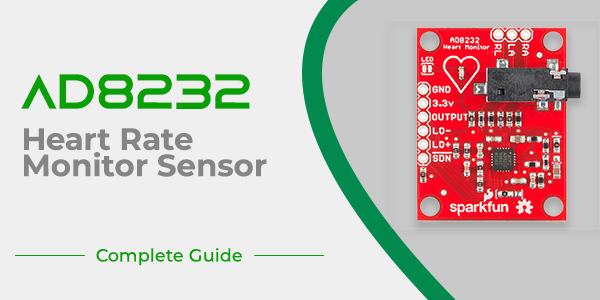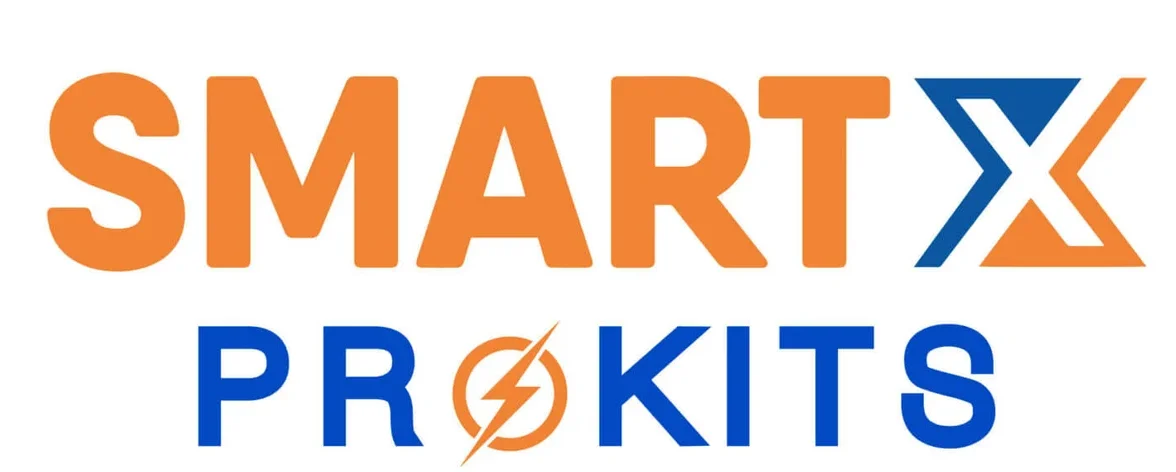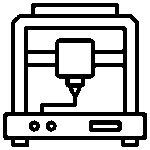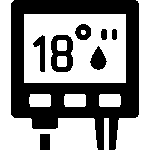AD8232 Heart Rate Monitor Detail Guide; Interfacing with Arduino
The Heart Rate Monitor Kit with AD8232 ECG sensor module Kit For Arduino is a cost-effective board used to measure the heart’s electrical activity. In this article, we will see its interfacing with Arduino along with the code.

The AD8232 is a very useful sensor that measures the heart’s electrical activity, Known as ECG. ECG, also known as EKG or Electrocardiography, is measuring electrical changes generated by cardiac movement. Cardiac disease is the main concern nowadays for people over the ’50s. This signal is attributed, at least partially, to more sedentary and stressful lifestyles and unhealthy habits. But genetics may also play a role. Hence we cannot ignore heart disease by analyzing or monitoring the ECG signal at the initial stage.
Electrocardiogram (ECG) is a common medical test for assessing cardiac function by measuring the heart’s electrical activity. This electrical activity can be charted as an ECG or Electrocardiogram. is used to help diagnose various heart conditions. Moreover, Its possible to design a low-cost ECG machine using Arduino and an AD8232 ECG sensor. AD8232 is a cost-effective ECG analog sensor for measuring the electrical activity of the heart.
The AD8232 single lead ECG heart rate sensor converts heartbeat into an analog signal. The signal allows us to monitor the heartbeats using even the most basic Arduino IDE build-in examples. In this article, we will interface this AD8232 heart rate sensor with Arduino. We will see how it shows us the ECG waveforms and the output on a serial plotter or Processing IDE.
What is ECG? How does it Work?
The ECG technology is noninvasive, which means it doesn’t physically penetrate the skin. However, putting conductive electrodes onto the skin can be dangerous. You will have to know what you are doing with the sensor. We strongly recommend using a low voltage AC power supply such as a 5 Volt power bank or a USB port from an unplugged laptop to avoid any potential damage.
ECG is the graphical recording of the heart’s electrical signals, and it is useful in obtaining any person’s heart rate and rhythm. Moreover, it serves as an indication to heart-related activities. Hence it points out certain heart-related problems also. The ECG graph contains repetitive cycles, and each cycle contains P, Q, R, S intervals.
The sinoatrial node (SA) is the pacemaker of the heart and produces the P wave.
The QRS wave is produced by the atrioventricular node (AV). The P wave in an ECG complex indicates atrial depolarization.
The QRS is responsible for ventricular depolarization, and the T wave is ventricular repolarization. QRS wave comprises a small Q wave, a high R wave, and a small S wave. The QRS segment offers information about the ventricular systole concerning the impulse propagation of the ventricles (Q wave). The R and S waves cause the transmission to the whole tissue.
Medical Uses of ECG
An electrocardiogram can be a useful way to determine whether your high blood pressure has caused any damage to your heart or blood vessels. Because of this, you may be asked to have an ECG when you are first diagnosed with high blood pressure.
- It detects cholesterol clogging on the heart.
- Possibility of heart attacks or past heart attacks.
- Enlargement of one side of the heart.
- Abnormal heart rhythms or dope-lope.
Overview of Sensor
AD8232 is the ECG sensor module with an integrated circuit. It is useful for measuring and monitoring the electrical activity of the heart or heartbeat. It is made up of a high-quality chip. It can be useful for building fitness, heart exercises for heart rate monitoring. It can be used as a portable ECG or remote heart rate monitoring. In addition, it is used to help diagnose various heart conditions.
This sensor is a cost-effective board. This electrical activity can be charted as an ECG or Electrocardiogram and output as an analog reading. However, ECGs can be extremely noisy, and the AD8232 Single Lead Heart Rate Monitor acts as an op-amp to help obtain a clear signal from the PR and QT Intervals easily.
The AD8232 is an integrated signal conditioning block for ECG and other bio-potential measurement applications. It is designed to extract, amplify, and filter small bio-potential signals in the presence of noisy conditions, such as those created by motion or remote electrode placement.
Specifications of AD8232 Heart Rate Monitor Sensor
The AD8232 Heart Rate Monitor breaks out nine connections from the IC that you can solder pins, wires, or other connectors to SDN, LO+, LO-, OUTPUT, 3.3V, GND provide essential pins for operating this monitor with an Arduino or other development board.
Features:
- Operating Voltage – 3.3V
- Analog Output
- Leads-Off Detection
- Shutdown Pin
- LED Indicator
- 3.5mm Jack for Biomedical Pad Connection or Use three-pin header.
Components Required for Interfacing
Connect the sensor to the Arduino according to the above diagram.
- Connect the GND of the sensor to the GND of the Arduino.
- Connect 3.3V to the 3.3V of the Arduino.
- Connect an output of the sensor to the A0 of the Arduino.
- Connect LO- to PIN 11 of the Arduino.
- Connect LO+ to PIN 10 of the Arduino.
- Keep SDN pin unconnected.

Final Words
Hope you find this AD8232 ECG sensor module interesting by reading this article. If you are curious about your heart rate and want a healthy heart, this sensor is the cheapest option. You can monitor heart rate by yourself with the help of this sensor. If you like this article, share it as much as possible.



















